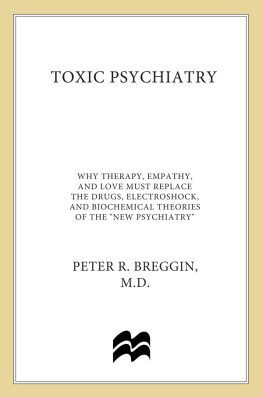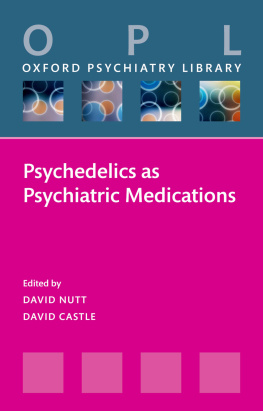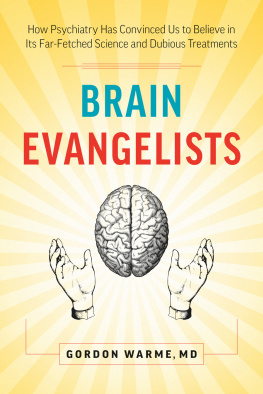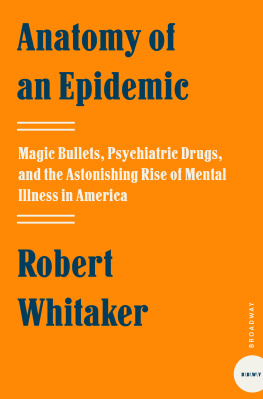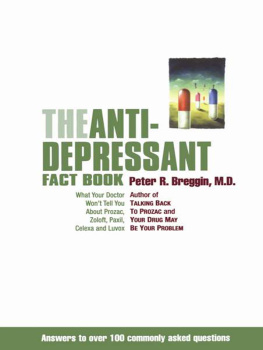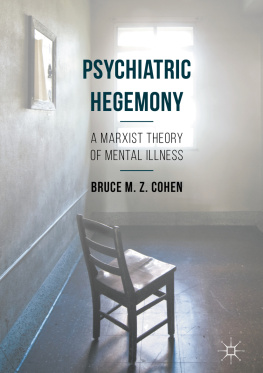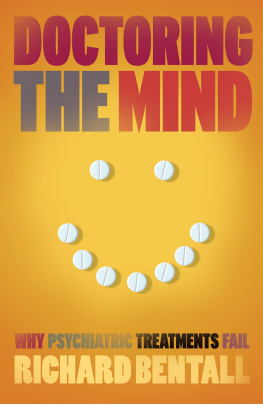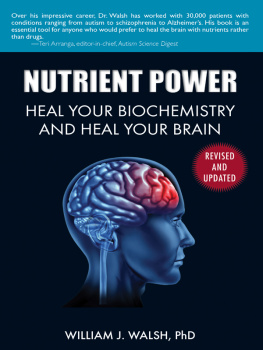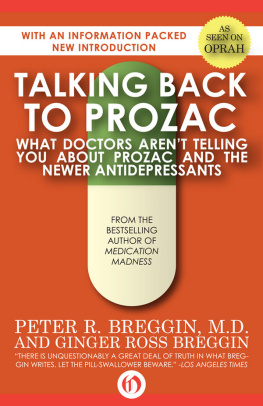Contents
Guide
T OXIC
PSYCHIATRY
Why Therapy, Empathy, and Love Must Replace the Drugs, Electroshock, and Biochemical Theories of the New Psychiatry
Peter R. Breggin, M.D.
St. Martins Press
New York
The author and publisher have provided this e-book to you for your personal use only. You may not make this e-book publicly available in any way. Copyright infringement is against the law. If you believe the copy of this e-book you are reading infringes on the authors copyright, please notify the publisher at: http://us.macmillanusa.com/piracy.
For my wife, Ginger Ross-Breggin
For helping me to love and to understand life
Do not abruptly stop most psychiatric drugs!
Most psychiatric drugs are far more dangerous to take than people realize, but they also can become dangerous when discontinued too abruptly. As described in this book, most have addictive qualities and can produce withdrawal symptoms that are emotionally and physically distressing and sometimes life-threatening. Drugs that can produce withdrawal symptoms include neuroleptics or antipsychotics, such as Haldol or Thorazine; antidepressants, such as Tofranil and Elavil; stimulants, such as Ritalin; minor tranquilizers, such as Valium and Xanax; and prescription sedatives or sleeping pills.
Stopping psychiatric drugs should usually be done gradually, and only with professional guidance.
No book can substitute for individualized medical or psychological care. However, it is important to find help consistent with ones own philosophy. The aim of this book is to present a psychosocial viewpoint. It cannot be used as a treatment handbook.
This book is the culmination of a lifetime of scientific, educational, and reform work and therefore draws insights, information, inspiration, and sustenance from many different people.
Most important is my wife, Ginger Ross-Breggin, who guided me, in the most gentle fashion, toward finding a more popular style of writing about complex technical subjects and helped edit the entire manuscript. She developed the filing system required for such a mammoth endeavor and carried on myriad back-up tasks over the years. She helped discover relevant research materials and often contributed directly to my grasp of the subjects. Yet her most important contribution cannot be described so simply. It has more to do with how she liveswith love and concern for all expressions of life and for the earth itself. She keeps me better connected to both the details and the essence of life. Our mutual feeling that there is an equal exchange between us is a blessing. During this time, Ginger also has been going to school, developing her artistic talents, delivering papers, coauthoring a book with me on conflict resolution, and being a mother to our children.
The influence of Leonard Roy Frank permeates the book. Himself the victim of electroshock and insulin coma when he was a young man, he has gone on to become a leader in psychiatric reform through his educational, organizational, and literary efforts. A constant stream of relevant books and articles has flowed across the continent from Leonards library and files to mine. He, too, read and helped to edit the entire manuscript and, next to my wife, provided the most important input. His generosity and spiritual verve have been a constant source of encouragement. Leonard is now compiling a book of quotations, from which most of the quotations at the chapter headings of this book are drawn.
Pam Clay, an outstanding patient rights attorney, embodying the best traditions of law, has made a significant impact on the care of inmates in her state of Kentucky. She read the entire manuscript and made many valuable comments; but her main contribution has been in the regular sharing of her enormous enthusiasm and intelligence, and her inspiring devotion to the rights and well-being of those too powerless to protect themselves.
In addition to Ginger, Leonard, and Pam, several other people have read some or all of the manuscript, as well as giving me other reasons to be grateful to them. Rae Unzicker, national coordinator of the National Association of Psychiatric Survivors (NAPS), triumphed over years of psychiatric abuse to become an outstanding leader in psychiatric reform. She has regularly bestowed her extraordinary warmth on me. Jeffrey Moussaieff Masson became the first psychoanalyst to defrock himself rather than promote the self-serving cultishness of the psychoanalytic establishment. As someone who has stood up for principle at great personal cost to himself, Jeffrey has been able to provide me extra infusions of moral support and courage. He also provided important materials for the book. Another brave individual, neurologist John Friedberg, became the first physician to stand up effectively in public against electroshock, and he belongs in the medical hall of fame for bravery. He has helped educate me over the years. Robert Morgan and Bertram Karon, psychologists and authors, have persistently told the truth about psychiatric fictions in their own writings and have lent me their support. A psychologist, writer, and former president of the American Academy of Psychotherapists (AAP), Larry Tirnauer has been a regular confidant through the ups and downs of my reform efforts, often adding needed balance to my critiques. As an author, Kate Millett inspired me to reexamine my attitudes on feminist issues in the early 1970s, and more recently she has become a friend and coworker on behalf of patient rights. Psychiatrist Eileen Walkenstein, another source of personal support, has written several books critical of biopsychiatric dogma and practice and promoting a more caring, mutual approach to patients. Psychiatrist Gerald Dubin has been for many years an unfailing friend and supporter and, before he retired from psychiatry, a model of kindness and gentleness as a psychotherapist. Neurologist Robert Grimm, M.D., a marvelous physician, long-standing friend and moral support, made useful contributions to the editing, as did sociologist Phil Brown, Ph.D., and professor of social work David Cohen, Ph.D.
Over the years of reform work, Ive also had useful input, help, and moral support from many other people to whom I want to express my gratitude, including psychiatrists Loren Mosher, Giovanni de Girolamo, David Richman, and Robert Seidenberg; social psychiatrist Ruth Peachey; educator Marshall Fritz; audiovisual specialist James Turney; patient advocates Bill Johnson and Mary Olympia, who are mainstays of the National Association of Rights Protection and Advocacy (NARPA); the entire board of directors of NARPA, including Paul Freddolino and Renee Bostick; physicians Lawrence Plumlee, Jay Salwen, and Lars Martensson; psychologists Les Ansel, David Hill, Seth Farber, and Judi Striano; mediation counselor Ingrid Kepler-May; social worker Michael Weinberg; filmmaker Beverly Jones; Ira Gruber and Sonja Kjaer of the Tardive Dyskinesia/Tardive Dystonia National Association; and Helen Geis, the parent of a psychosurgery victim. I also want to thank Diana James, assistant to Gloria Steinem, for offering moral support as I have increasingly confronted the issues of male supremacy in psychiatry and society.
Many other people, too numerous to mention, have mailed me a constant stream of news clippings and other materials from around the world, and I want to thank them and to ask them to keep it up.
Many members of the psychiatric survivor movement were interviewed for the book or otherwise contributed through conversations, correspondence, published writings, or organizational activities. Beyond those already mentioned, I want to thank Don Weitz, Irit Shimrat, Sally Zinman, Jenny Miller, Sandra Everett, Marilyn Rice, Fancher Bennett, John Basham, Ron Thompson, Linda Andre, Jay Mahler, Susan Witte, Howie the Harp, Janet Foner, Janet Gotkin, Lynda Wright, Huey Freeman, George Ebert, Mary Ann Ebert, Paul Dorfner, Dayna Caron, Peter Lehmann, Karl Jensen, Lise Smedal, Caia Garupi, Maths Jespersen, and activist attorneys Jean Matulis, Ted Chabasinski, and Carla McKague. Among the survivors, I especially want to acknowledge David Oaks, who gives voice to the movement through his journal,

